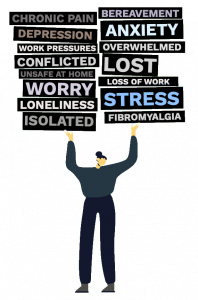#WMHD2021
Having worked in the Wellness Hub for around 18 months now, I have seen many different patients, and their different stories, walk through my door. They often sit down on the sofa, put their hands in their lap, and begin telling me various diagnosis they believe they might have, have had, or know someone who has had. They talk in the language of symptoms, eager to use this precious time to get the most pertinent information across to me, in the hopes that I might be able to do something to help them, and fast. Of course I listen attentively, keen to understand what has brought them to see me.
I ask the normal questions,
“Have you noticed any changes in your sleep?”
“Has your appetite changed?”
“Have you experienced any thoughts about hurting yourself?”
They answer me diligently, trying to get me to understand just how serious this is for them, how much they need help. It is really important to both them, and me, that a plan is created that feels appropriate, comfortable, and proportionate to what they are feeling. This whole exchange is often a peak moment for my patient, they are usually anxious beforehand and it is not unusual that they bring in lists of things that they must tell me.
“When you came here today, what were you hoping for? What did you hope would be the outcome?”
Stumped. So often, my patients become stumped. I get replies of “well.. I’m not entirely sure” or “I hadn’t really thought of that”. Perhaps in previous interactions, they had awaited a plan to be delivered to them. A plan that they would scrutinise carefully and follow to the T (or not) and hope for a swift change.
I’ve always worked under the assumption that people are experts of their own experience. They know, in reality, if they actually want to take up more exercise, or join a slimming group. They know whether it is likely they will cut out takeaways or commit to a smoking cessation programme. They also know whether it is more likely that they can commit to say, walking to collect their children from school rather than driving. Or, that the smaller commitment of making sure they drink enough water is much more reasonable and “do-able”.
Reminding them, the power is always in their hands, and gently guiding them to notice this is truly a wonder that I get to share with nearly all of my patients.
Once they notice this, once they realise that their own health goals are attainable, the motivation can spread like wildfire. Rather than feeling disappointed at not reaching goals “I” have set, they become excited at meeting their own meaningful and realistic targets. They aren’t doing this for me, or for their GP, or for their consultants; They are doing this for themselves.










